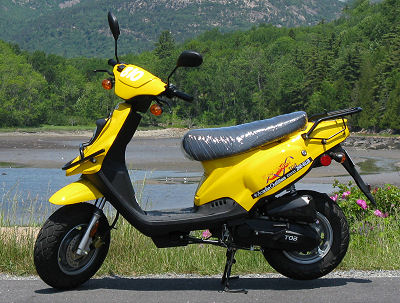Scooter Wheel and Tire Size
Motor Scooter wheel size varies from a minimum of about 10" to a maximum of around 16". Most are either 12" or 13". This is the size of the metal wheel itself and doesn't include the tire. The measurements is the diameter of the wheel rims The tire may add 5" or 6" to the diameter. My scooter has 13" wheels (rims), but the tire measures about 19" across in total.
So what are the advantages and disadvantages of different sized wheels?
Well, the smaller the wheel the more manouverable the scooter can be. The smaller wheel has less of a gyroscopic effect making it somewhat easier to turn (though this also depends a lot on steering geometry). So in general, scooters are more manouverable than motorcycles (which have larger wheels). The converse of this is that larger wheels may give better stability at speed.

50cc scooter with small 10" wheels
The downside of smaller wheels is that they don't roll over obstructions in the road as well. Just think of a pothole in the road. If it's a large hole and a small wheel, the wheel could fall into it! Even if it's a raised obstruction like a tree branch or a kerb, a larger wheel will roll over it with less effort than a small wheel. That's one reason why off-road trucks often have monster wheels. When you're driving over rocks a big wheel makes life easier. Similarly, if you're riding over roads filled with potholes (for example New York City!), you'll value larger wheels.
Scooter with 13" wheels
While a few scooters have 16" wheels (e.g. the Kymco People 150) and a few have 10" wheels (like the Honda Elite 80), most scooters have a 12" or 13" wheel which is a reasonable compromise between manouverability and stability.
Scooter Tires
Scooter tires come in all sizes of course, with a typical 13" wheel scooter tire having a designation something like "130/60-13". The "13" refers to the wheel rim diameter. The "130/60" part indicates that the width of the tread is 130mm (5.1") and that the tire has an aspect ratio of 0.60 (or 60%), which means that the sidewall height is 60% of the width of the tire. Some tires are designed for front wheel use, some for rear wheel use and some can be used on either wheel. Though most tires today are tubeless, there may still be a few tires which require an inner tube, especially on older scooters.

The tread pattern may be directional, meaning that it has to be mounted the correct way around to perform properly and there should be an arrow on the sidewall which shows which way the tire should rotate. You may also see a speed designation on some tires between the "130/60" and "13". This is a letter which runs from "J" to "Y". "J" indicates the tire is safe to use up to 62mph, "L" is up to 75mph, "N" is up to 87mph, "P" is up to 93mph and "S" is up to 103mph. You probably won't be going any faster than that on a scooter. However there is a "W" designation shows the tire is safe up to 168mph. As far as I know there are no "W" rated scooter tires! Most scooter tires will be priced in the $35-$70 region. BikeBandit (see above) and Motorcycle Superstore (see below) are two of the on-line companies which sell scooter tires.
It hard to say who makes the best tires, but Michelin has an excellent reputation and they have many years of experience providing scooter tires for the European market. Dunlop, Avon, Pirelli and Bridgestone also make excellent scooter tires. Kenda make tires in Taiwan, China and Vietnam for the US scooter and ATV market. Shinko is a Taiwanese tyre maker who produce scooter and motorcycle tires. Cheng Shin make tires in China for scooters, motorcycles, ATVs and golf carts. The price difference between a premium tire like a Pirelli or Michelin and a low priced tire like a Cheng Shin is usually less than $25. Personally, I'd go for the more expensive tire from a European or Japanese tire maker. The tire is the only thing between you and the pavement and it's not an area where I'd cut costs by buying the cheapest tire I could find!